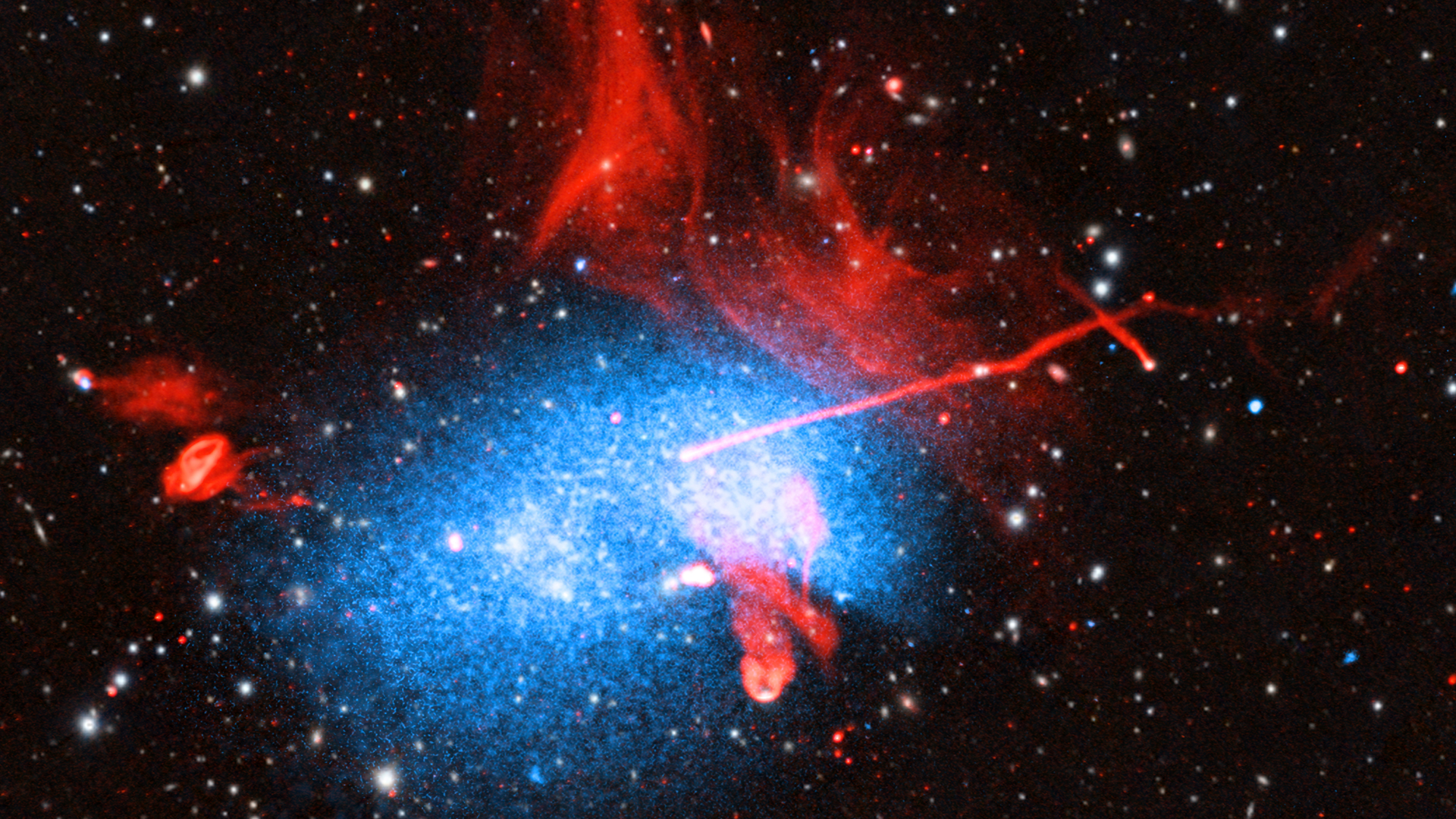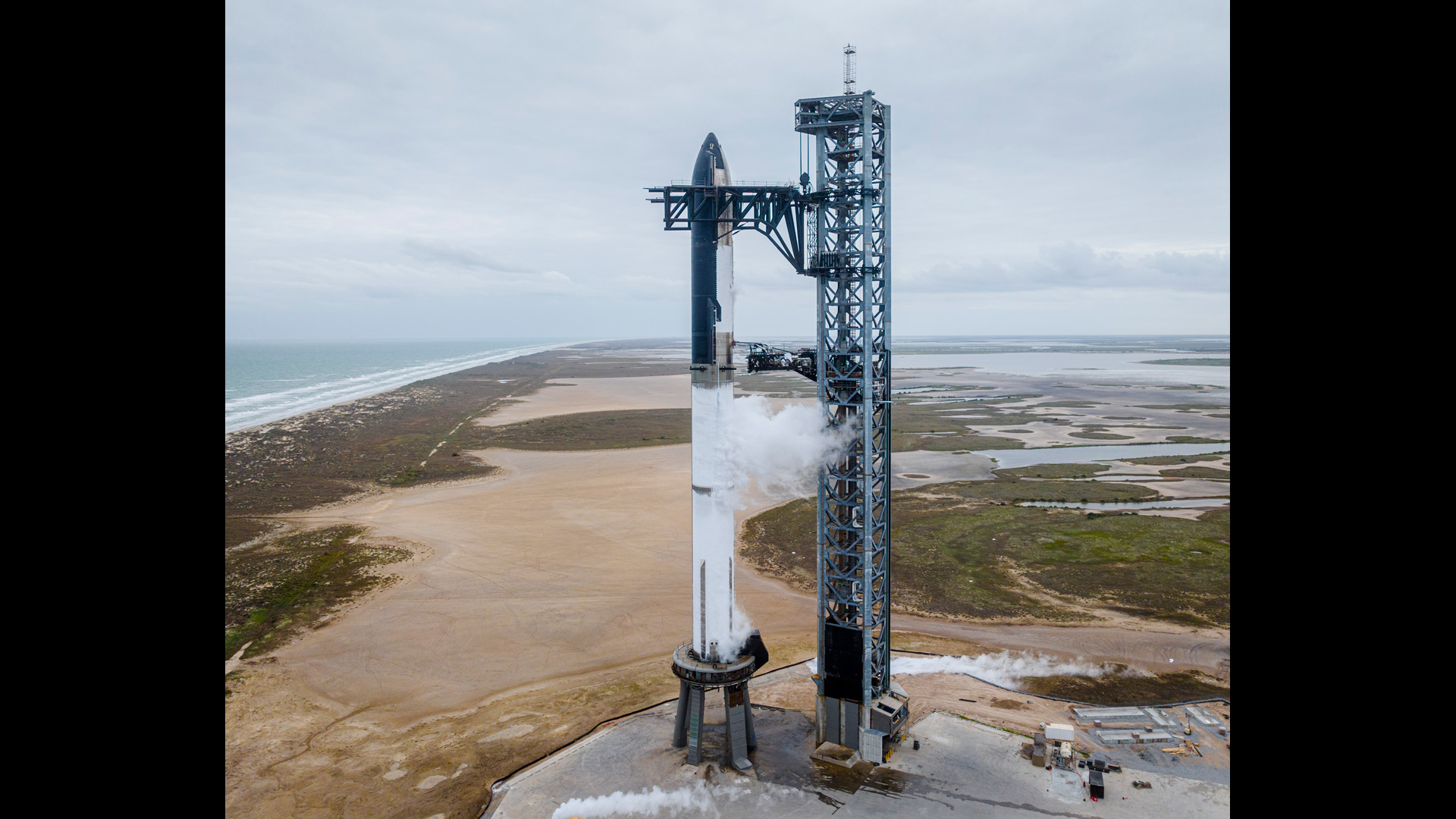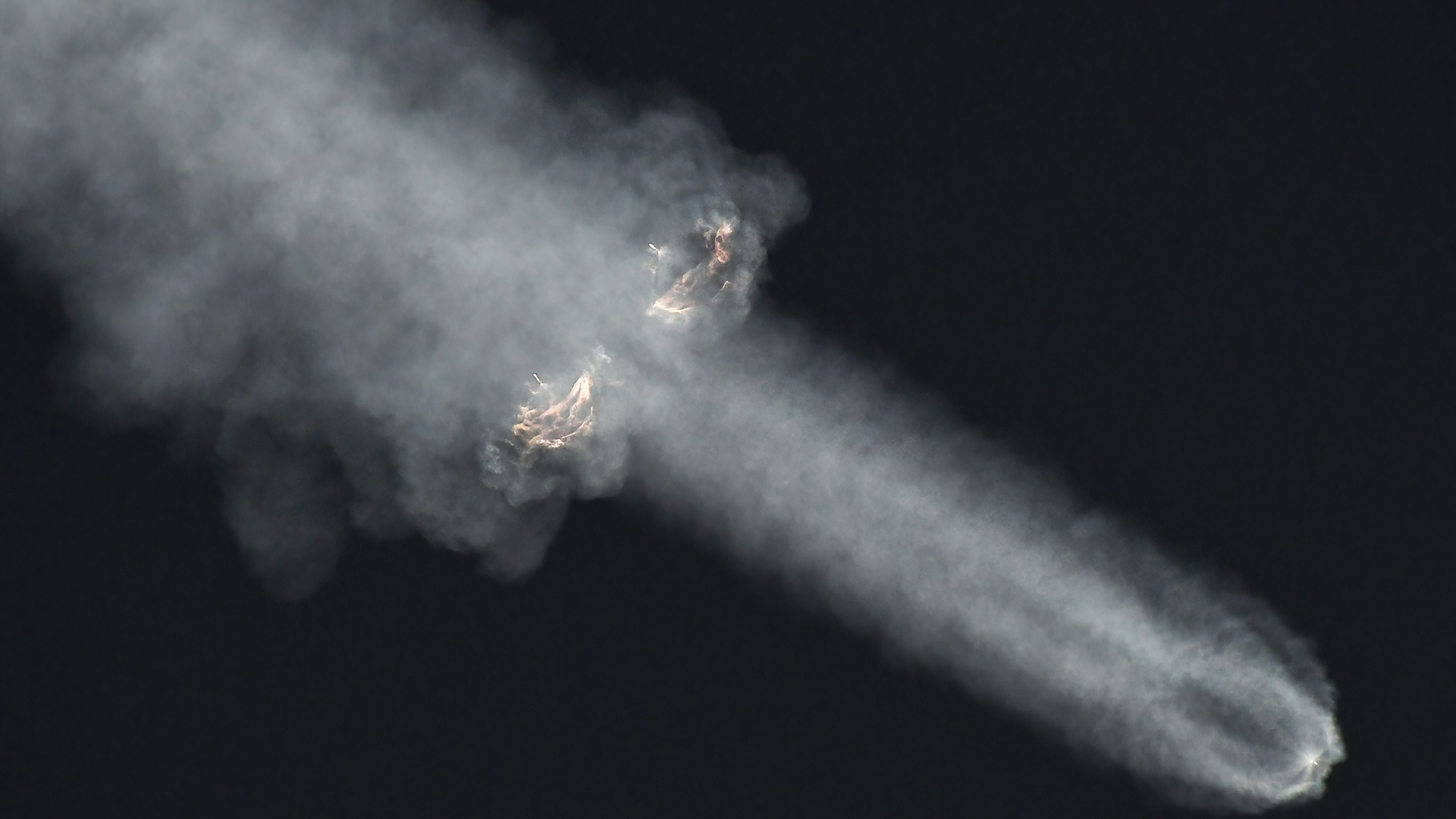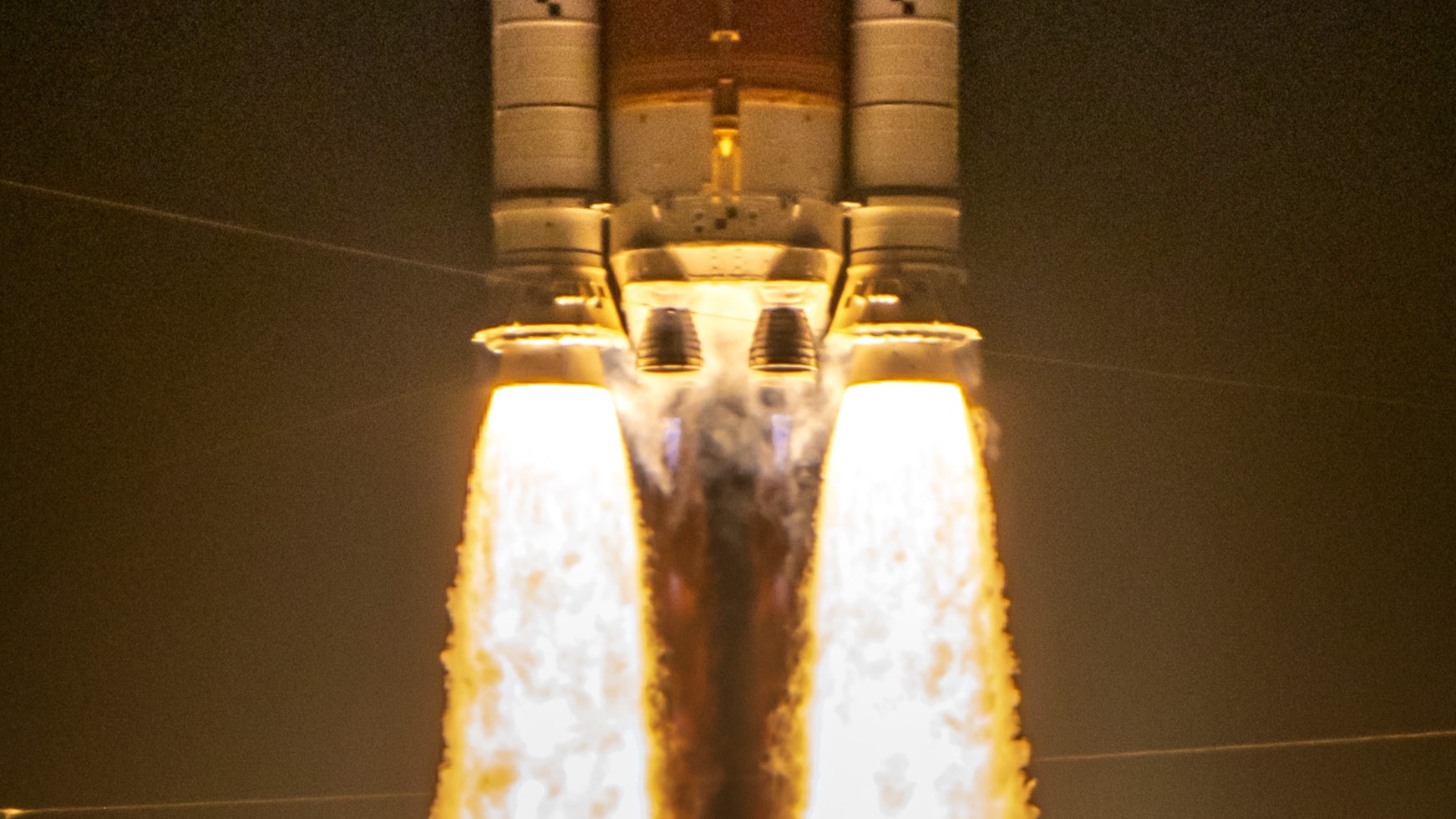Take a trip through time and space to explore all Space.com's Image of the Day photos from 2023!
January 2023
Trio of spacecraft observes giant collision in distant universe

Tuesday, January 31, 2023: Three enormous galaxy clusters are caught in the middle of a collision in this image consisting of observations made by NASA's Chandra X-ray Observatory and the European Space Agency's XMM-Newton.
A new galaxy cluster is emerging from this collision some 780 million light-years from Earth, known as Abell 2256. In addition to X-ray observations from Chandra and XMM-Newton, the image also contains data from three Earth-based radio telescopes and one optical telescope.
Each of the telescopes provides a unique view into the processes that are underway in this giant structure that contains hundreds or thousands of individual galaxies. The X-ray component measured by Chandra and XMM reveals the location of the superhot gas filling this cluster. In this image, the gas, with temperatures of several million degrees Fahrenheit, is shown as the central bright bluish cloud.
The three radio telescopes involved, the Giant Metrewave Radio Telescope in India, the Low Frequency Array in the Netherlands, and the Karl G. Jansky Very Large Array in New Mexico, spot material emitted from supermassive black holes at the centers of individual galaxies. In this image, these radio emissions are shown as bright blots of light coming from the red-colored regions. The radio telescopes also see a vast mass of cosmic filaments depicted as the large red cloud.
Infrared and optical observations by the Pan-STARRs telescope in Hawaii are shown as dots of white and pale yellow. – Tereza Pultarova
Scary shark nebula floats above an Egyption observatory

Monday, January 30, 2023: An Egyptian astrophotographer captured this awe inspiring image of the scary Shark nebula in the constellation of Cephus lurking above Egypt's Kottamia Observatory.
"This has been the hardest object I've ever captured," Weal Omar, the author of the image and keen astrophotographer, told Space.com in an email. "It's a real challenge for anyone who loves astrophotography."
Get the Space.com Newsletter
Breaking space news, the latest updates on rocket launches, skywatching events and more!
The Shark nebula is a giant cloud of thin interstellar dust and gas some 650 light-years away from Earth. Although the monstrous nebula has 15 light-years across and appears in the sky as large as 10 moons stuck next to each other, the Shark is notoriously difficult to photograph due to the wispy nature of the cloud.
This image is a composition of several shots taken on three separate nights in a remote area near the Kottamia Astronomical Observatory, the largest telescope in the Arab world, which is located some 50 miles (80 kilometers) from Egypt's capital Cairo.
"It was such scary night," Omar wrote in the email. "I heard different night animal sounds during the session, I was so scared that I even thought it was alien sounds." – Tereza Pultarova
A close-up image of the iceberg that broke off an Antarctic ice shelf this week

Friday, January 27, 2023: This detailed image shows the gap opening between the Brunt Ice Shelf in Antarctica and the iceberg that split from it on Saturday (Jan. 21).
The high-resolution image was taken by satellites of the U.S. Earth-observation company Planet on Tuesday (Jan. 24). The calving of the iceberg has nothing to do with climate change, according to experts, and was a result of natural processes that had been underway for over a decade. The iceberg split along a crack known as Chasm-1 that scientists had monitored since 2012. The new fragment, which is now slowly being carried away by the Antarctic Coastal Current, is about 600 square miles (1,550 square kilometers) in size, about as big as the London metropolitan area or little larger than Houston.
The Brunt Ice Shelf hosts the British Halley VI Research Station, which had to be moved in 2016 away from the crumbling ice block. – Tereza Pultarova
SpaceX destacks Starship ahead of booster fire test

Thursday, January 25, 2023: SpaceX has destacked its Starship megarocket after an important pre-launch test in order to perform further separate testing on the vehicle's two stages at its Starbase facility in South Texas.
"Launch and catch tower destacked Ship 24 from Booster 7 on the orbital pad today ahead of the Booster’s static fire test," SpaceX said in a Tweet.
Ship 24 is the name of this particular Starship upper stage, while Booster 7 is the first stage of the 395-foot-tall (120 meters) vehicle. The company will now perform a static fire test on Booster 7, which will involve firing all the stage's 33 Raptor engines for the first time.
To date, Booster 7 has static-fired a maximum of 14 of its 33 Raptors simultaneously. Ship 24 lit up all six of its Raptors last September. SpaceX's CEO Elon Musk previously said the giant rocket, which dwarfs even NASA's Space Launch System moon rocket, may perform its debut orbital flight as early as next month. – Tereza Pultarova
Newly discovered asteroid seen approaching Earth

Wednesday, January 25, 2023: A newly discovered asteroid that will pass very close to Earth on Friday has been photographed by an Italian astronomer as it makes its approach.
The space rock, called 2023 BU, is only about 13 to 30 feet (4 to 9 meters) wide, and was discovered last Saturday (Jan. 21) by prolific Crimea-based astronomer and telescope builder Gennadiy Borisov (the same man who discovered the first interstellar comet, which now bears his name, Borisov, in 2018)
The asteroid will pass only 2,240 miles (3,600 kilometers) from Earth's surface on Friday (Jan. 27), becoming the 4th closest asteroid ever observed apart from those that actually struck the planet, according to the Virtual Telescope website. For comparison, satellites of the global navigation system GPS orbit 12,500 miles (20,200 km) above Earth, about four times farther away.
This image, however, was taken when the asteroid was still quite far, about 360,000 miles (580,000 km) away from us, which is 124,000 miles (200,000 km) farther away than the orbit of the moon.
Italian astronomer Gianluca Masi took the image on Tuesday (Jan. 24) using his robotic Elena telescope located just outside of Rome. – Tereza Pultarova
SpaceX's Starship on launchpad during major test

Tuesday, January 24, 2023: SpaceX's Starship megarocket is sitting on a launchpad at the company's Starbase facility in South Texas during a major test ahead of its debut flight.
During the test, the 395-foot-tall (120 meters) Starship, which is taller than NASA's Space Launch System moon rocket, has gone through most of the procedures it will perform on launch day including loading liquid oxygen and liquid methane propellant into the vehicle's Super Heavy first stage and Starship upper stage.
SpaceX said on Twitter it will now "destack" the rocket's stages in order to perform a static fire test with the Super Heavy's 33 Raptor engines. – Tereza Pultarova
Watch the Gulf Stream whirl across the Atlantic Ocean

Monday, January 20, 2023: The Gulf Stream whirls through the Atlantic Ocean in this image sequence based on data from European Earth-observation satellites as it transports warm water from the Caribbean toward western Europe.
The animation shows the evolution of the Gulf Stream in December 2022 and January 2023. The Gulf Stream plays an important role in European climate, warming it up considerably compared to what it would be like without it.
Scientists worry that climate change could disrupt the Gulf Stream in the future, plunging northwestern Europe into a mini ice age. Existing data already suggest that the warming steam is slowing down and potentially nearing the point of collapse. – Tereza Pultarova
Catastrophic flooding in California seen from space

Friday, January 20, 2023: Satellites of U.S. Earth observation company Planet have documented the extent of the catastrophic floods and landslides that hit California following a series of devastating storms earlier this month.
In this image, taken on Jan. 1, fields around the city of Elk Grove, near Sacramento, are seen submerged in dirty brown water in the aftermath of record-breaking downpours. Similar images have come from other parts of the sunny state, which usually struggles with drought. The storms and ensuing floods and landslides have killed at least 22 people across California. – Tereza Pultarova
Austrian astrophotographer captures Comet C/2022 E3 (ZTF) losing its tail

Thursday, January 19, 2023: An image taken by an Austrian comet hunter reveals a disconnection in Comet's C/2022 E3 (ZTF) tail that may have been caused by turbulent space weather.
Seasoned astrophotographer Michael Jäger took this image on Tuesday (Jan. 17) after driving 500 miles (800 kilometers) from Austria to Bavaria in Germany to get a clear view of the sky.
"The journey was not in vain," Jäger told Space.com in an email. He added that when it comes to comets, an astrophotographer can waste no time as these icy balls change rapidly when they reach the warmer regions in the inner solar system.
This particular image reveals what astronomers call a disconnection event, essentially a weakening in the comet's trademark tail, which makes it look as if the tail was breaking off.
According to SpaceWeather.com, this disruption in the tail is likely caused by turbulent space weather, namely the stronger than usual solar wind that has been released during a recent coronal mass ejection (CME). CMEs are bursts of highly energetic particles emitted from the sun's upper atmosphere, the corona, that travel across the solar system, interfering with the atmospheres of planets and other bodies.
C/2022 E3 (ZTF), which was discovered by the Zwicky Transient Facility (ZTF) at the Palomar Observatory in California in March 2022, is making its first close approach to Earth in about 50,000 years. The comet will soon become visible to the naked eye, experts say, and will reach its closest distance to Earth on Feb.1, zooming past our planet at about one quarter the sun-Earth distance.
Jäger, who has photographed more than 1,100 comets since he took up astrophotography four decades ago, is certain to take more awe-inspiring images, which you can find on his Twitter account. – Tereza Pultarova
Earth-sized sunspot photographed in strange hydrogen light

Wednesday, January 18, 2023: A British astrophotographer has taken this image of a larger than Earth sunspot that has been battering our planet with solar flares in the past few days.
The sunspot, named AR 13190, is so large that it can be seen without a telescope, with the naked eye just with the help of sun-observing eclipse glasses (don't look at the sun's disk with unprotected eyes).
The image, taken by retired molecular biologist and life-long astronomy enthusiast Kevin Earp and shared on his Twitter account on Tuesday (Jan 17), shows the star at the center of our solar system in a specific part of the light spectrum that is emitted by energetic hydrogen atoms in the sun's chromosphere, the lower layer of the sun's atmosphere.
"This image was taken with a 100mm refractor and Daystar Quark [filter] to capture the light of hydrogen-alpha, which is not visible to the unaided eye," Earp told Space.com in an email.
In his tweet he added that taking the image was rather difficult due to the low position of the sun in the sky in this part of the year in the U.K, where he is observing from.
"Seeing in h-alpha was awful today with the #sun being so low, but I managed to catch the largest spot currently on the disk," he said, adding that "Earth could fit comfortably inside the dark umbra [the dark area of the spot], at a toasty 3,700 degrees Celsius [6,692 degrees Fahrenheit]". – Tereza Pultarova
The other greenhouse effect

Tuesday, January 17, 2023: A satellite image by U.S. Earth observation company Planet shows the Spanish Almería region covered with vegetable greenhouses. Nearly all of the ground in this 100 square-mile (260 square kilometers) area is now buried underneath plastic foil, which reflects incoming sun rays so efficiently that the region has actually cooled down in the recent decades in spite of the progress of climate change. Could this be a solution to our planet's global warming problems?
The traditionally agricultural Almería has seen its greenhouse city grow since the late 1980s as local farmers sought to increase the yields of tomatoes, cucumbers, watermelons and other produce. Spanish researchers found years ago that the sun-reflecting properties of the foil used to make the greenhouses cooled down the area by more than 0.5 degree Fahrenheit (0.3 degree Celsius). That's quite notable, considering the fact that the rest of Spain, together with the rest of Europe, is warming at a faster rate than the rest of the world. Does it mean we need more greenhouses in Europe? -Tereza Pultarova
SpaceX's Falcon Heavy launches for its fifth mission

Monday, January 16, 2023: SpaceX's Falcon Heavy rocket has lifted off for its fifth mission in history from NASA's Kennedy Space Center in Florida on Sunday (Jan. 15), lofting into orbit a secret payload by the U.S. military.
The mission, called USSF-67, was propelled into space by three modified Falcon 9 first stage boosters, two of which later successfully landed at Cape Canaveral Space Force Station, across the Banana River lagoon from Kennedy.
The third booster fell into the Atlantic Ocean as planned as it used too much of its fuel to perform a safe landing. – Tereza Pultarova
SpaceX's megarocket Starship seen from space

Friday, January 13, 2022: Satellites of European aerospace firm Airbus photographed SpaceX's megarocket Starship after it had been stacked on a launch pad at the company's Boca Chica test site in South Texas.
SpaceX is currently preparing for the debut orbital flight of the 395 feet (120 meters) tall rocket, which is taller than NASA's Space Launch System that launched the Orion spaceship for the Artemis 1 uncrewed test-flight in November.
According to SpaceX CEO Elon Musk, Starship, comprising the Ship 24 upper-stage spacecraft atop the Booster 7 first stage, could blast off for its first-ever space trip as early as late February. – Tereza Pultarova
Snoopy finally exits Orion after moon-trip

Thursday, January 12, 2022: Snoopy, the zero-gravity indicator toy astronaut, has finally been freed from its transport case after its ground-breaking trip to the moon and back aboard the Artemis I mission's Orion spacecraft.
This image, captured on Jan. 5, shows the beagle shortly after it has been unloaded from Orion by ground support teams at NASA's Kennedy Space Center in Florida.
Snoopy wasn't selected for the 25-day test flight, which lifted off on Nov. 16, by accident. The character, first introduced in 1950, has links to Apollo-era spacecraft. The lunar module of the Apollo 10 mission (which served as a rehearsal for the first lunar landing) was named Snoopy after the dog.
During the Artemis 1 mission, the Snoopy toy traveled 1.4 million miles aboard Orion as the spacecraft broke the record for the farthest distance from Earth achieved by a human-rated spaceship. The previous record was held by Apollo 13, which, however, only got that far as part of a rescue operation after an onboard explosion shortly after launch scuppered the mission's original plan to land on the moon. – Tereza Pultarova
James Webb Space Telescope reveals unexpected star formation in dwarf galaxy on Milky Way's edge

Wednesday, January 11, 2022: The James Webb Space Telescope has found evidence of star formation in a tiny galaxy in the Milky Way's outskirts.
Webb pointed its powerful NIRCam instrument at the dwarf galaxy, the so-called Small Magellanic Cloud, which orbits our galactic home 200,000 light-years away from Earth, and found pockets of star formation that have never been seen before. The image reveals new structures that appear to feed the nascent stars. – Tereza Pultarova
Virgin Orbit's Boeing 777 Cosmic Girl readies for its first U.K. mission

Monday, January 10, 2022: Virgin Orbit's Cosmic Girl Boeing 777 readies for its first mission from the U.K. at Spaceport Cornwall.
The plane is set to take off with Launcher One under its wing for the first orbital mission from British soil. The mission, called Start Me Up is a historic moment for the U.K., which is now set to become the first country in Western Europe with the capability to launch satellites to orbit. – Tereza Pultarova
Nicole Mann enjoys space station views

Thursday, January 5, 2022: NASA astronaut and Expedition 68 Flight Engineer Nicole Mann is enjoying some relaxing time inside the International Space Station's cupola in this image released by NASA on Monday (Jan. 2).
The Cupola, attached to the U.S. Tranquility module, is a dome consisting of seven windows that allow astronauts to observe Earth as well as the depths of the universe. The Cupola is probably the favorite spot on the space station for most astronauts as it provides them with a unique overview of our home planet. In this image, Mann displays the U.S. flag inside the cupola in the window next to her. – Tereza Pultarova
America's new weather sat takes over from predecessor amid superstorm

Wednesday, January 5, 2022: The GOES 18 satellite of the U.S. National Atmospheric and Oceanic Administration (NOAA) has taken over from its predecessor GOES 17 while observing a massive storm swirling above the Pacific Ocean.
The image sequence in true colors captures the storm, which brought torrential rains to California by funneling moisture from Hawai'i.
In this video sequence, GOES18 imagery begins at 1800 GMT (the timecode is visible in the lower right corner of the video).
GOES18 launched in March 2022, but it took up till now to get the spacecraft to its correct position in the geostationary orbit at 22,000 miles (36,000 kilometers) above Earth's surface, from where the craft has a constant view of the western U.S. and the Pacific Ocean.
The storm triggered a widespread evacuation operation due to the risk of flash floods and landslides especially in areas ravaged last summer by wildfires. – Tereza Pultarova
Massive eruption explodes from the sun

Wednesday, January 4, 2022: A massive eruption of magnetized particles burst from the sun on Tuesday (Jan.3), accompanied by a powerful six-hour-long solar flare.
The eruption, a so-called coronal mass ejection (CME), emerged from a sunspot on the far side of the sun, and will not hit Earth, experts say. CMEs are clouds of highly charged particles from the sun's upper atmosphere, the corona. If directed at Earth, they reach the planet within a few days. Interactions of the charged solar particles with Earth's magnetic field trigger beautiful aurora displays but also cause all sorts of problems such as power blackouts, GPS disruptions and satellite malfunctions. Solar flares, on the other hand, are bright flashes of light that arrive at the planet within eight minutes and can briefly disrupt radio communications.
While the Tuesday CME, captured in this video sequence by NASA/ European Space Agency's Solar and Heliospheric Observatory (SOHO), will miss Earth, the sunspot that produced it will likely emerge from behind the sun's eastern edge within the next two days, possible causing some rough space weather conditions in the coming weeks. – Tereza Pultarova
Record-breaking January heatwave threatens Europe's glaciers

Tuesday, January 3, 2022: A record-breaking New-Year's heatwave has swept across Europe in the first days of 2023.
With temperatures at levels usually seen in late spring, the unusual heatwave is threatening the continent's precious mountain glaciers that are already on the brink of collapse due to climate change.
This image, taken by Europe's Sentinel-2 satellite, shows the town of Altdorf in the Swiss Alps, where daytime temperatures hit 67 degrees F (19.2 degrees Celsius) on Jan. 1 and stayed above 60 degrees F (16 degrees C) throughout the night. For Altdorf, which is nestled between snow-capped 9,800-foot-tall (3,000 meters) Alpine mountain ranges, it was the warmest New Year's Day since 1864.
The warm spell comes after a summer of disastrous glacier thawing across the Swiss Alps which saw 6.2% of the mountain ice disappear. Experts usually consider a 2% annual ice loss rate as severe, according to the Conversation.
New Year's Day temperature records were broken across many other central and western European countries including Denmark, the Netherlands, Poland and the Czech Republic. – Tereza Pultarova
Volcanic view

Monday, January 2: The two volcanic peaks of the island of Hawaii are covered in snow in this serene photo from the International Space Station.
At top is the dormant volcano Mauna Kea while the more active Mauna Loa volcano clearly stands out at the bottom. This image was taken by an astronaut on the space station as it sailed 258 miles above Hawaii on Dec. 27, 2022. - Tariq Malik
Can't find the date you're looking for? It may have been a weekend or holiday, when we don't normally update our Image of the Day.
Click 'NEXT PAGE' below for February >
Check out our Image of the Day Archives for more awesome photos.
Image of the Day 2024 Archive

Image of the Day 2023 Archive

Image of the Day 2022 Archive

Image of the Day 2021 Archive

Image of the Day 2020 Archive

Image of the Day 2019 Archive

Join our Space Forums to keep talking space on the latest missions, night sky and more! And if you have a news tip, correction or comment, let us know at: community@space.com.

Space.com is the premier source of space exploration, innovation and astronomy news, chronicling (and celebrating) humanity's ongoing expansion across the final frontier. Originally founded in 1999, Space.com is, and always has been, the passion of writers and editors who are space fans and also trained journalists. Our current news team consists of Editor-in-Chief Tariq Malik; Editor Hanneke Weitering, Senior Space Writer Mike Wall; Senior Writer Meghan Bartels; Senior Writer Chelsea Gohd, Senior Writer Tereza Pultarova and Staff Writer Alexander Cox, focusing on e-commerce. Senior Producer Steve Spaleta oversees our space videos, with Diana Whitcroft as our Social Media Editor.
